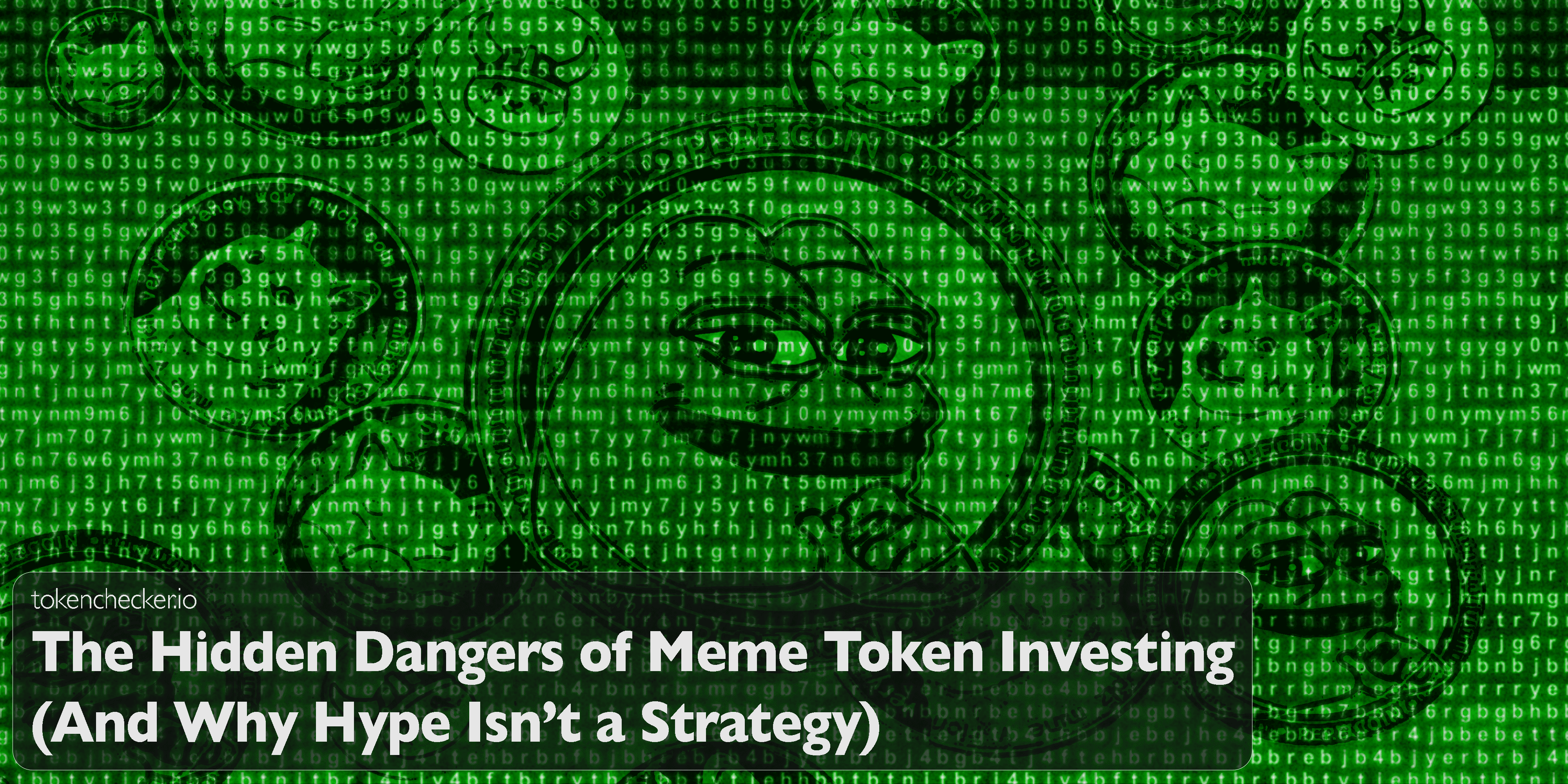
The Hidden Dangers of Meme Token Investing (And Why Hype Isn’t a Strategy)
Meme tokens are the casino chips of crypto. They’re flashy, affordable, and everywhere. And like casino chips, they make you forget that you’re playing with real money.
What started as a joke—Dogecoin, Shiba Inu—has turned into an entire class of “investments” driven by internet virality instead of fundamentals. But behind the memes, there’s a darker side: most meme tokens are financial traps disguised as fun. This article unpacks the true dangers of meme coins, from psychological manipulation to smart contract exploits, and shows how tokenchecker.io helps separate hype from reality.
What Are Meme Tokens, Really?
Meme tokens are crypto assets inspired by pop culture, jokes, or social media trends. Unlike utility tokens or platform coins like ETH or SOL, they usually have no clear use case. Their price is powered by attention—not adoption. A project's real value comes from its roadmap and use case, not just its virality.
Key traits of meme tokens:
- Massive token supply and low per-token cost
- Viral community hype on X, Telegram, and TikTok
- No product, roadmap, or working utility
- Easily forked or copied by anyone with minimal coding skills
- High volatility and short life spans
If that sounds like a setup for manipulation—you’re right.
The Financial Minefield
Volatility on Steroids
Prices can 10x on a tweet or drop 90% in an hour. It’s not driven by use or demand. It’s driven by sentiment. And that sentiment flips fast.
Case in point: TRUMP token surged 516% after a viral moment—then crashed 85% days later.
Liquidity Is a Lie
Many meme tokens launch with tiny liquidity pools. This means:
- Even small buys can artificially spike price
- Whales can pull the rug with one sell
- Slippage is brutal when trying to exit
If a token pumps too fast to be real, it probably is.
Manipulation Behind the Scenes
You’re not the only one watching that chart. So are bots, whales, and manipulators.
- Wash Trading: Makes volume look real
- Liquidity Pool Inflation (LPI): Small, strategic buys to fake demand
- Sniper Bots: Beat retail by milliseconds on launch
- Honeypots: Let you buy but block you from selling
- Soft Rugs: Devs drain value slowly while pretending to build
The “gem” you found? It might be a staged illusion.
Psychological Warfare in Meme Coins
FOMO: Weaponized Emotion
The promise of “easy 100x” hijacks your brain. One screenshot of a wallet turning $50 into $10k is enough to make you click “buy” without checking the contract. The psychology of FOMO is a powerful tool for scammers.
Retail buyers don’t get rugged because they’re dumb—they get rugged because they act emotionally.
The “It’s Just for Fun” Trap
Many meme coins position themselves as jokes or collectibles. But wallets don’t care if it’s a joke; you still lose money. This framing disarms your critical thinking.
Gamified Addiction
Trading meme coins feels like gambling. You get dopamine hits. You check charts obsessively. You feel smart when it pumps and sick when it dumps. It’s not investing—it’s a slot machine with memes.
The Echo Chamber Problem
Meme coin communities often turn into echo chambers:
- Every criticism is “FUD”
- Only bullish takes are allowed
- Dissenters get banned
- Hype replaces reality
This social pressure creates groupthink, leading to irrational decisions and making it easy for insiders to dump while everyone else holds the bag.
Scam-Fueled Virality
Many meme coins are intentionally designed to scam. Common exploit tactics:
- Hidden mint functions
- Self-destruct code
- Backdoors disguised as legit features
- Stolen branding (namesake attacks)
- Fake airdrops + phishing drainer sites
Celebrity endorsements are often fake or paid. Verified government X accounts have been hijacked to promote scam coins. Even legitimate influencers sometimes promote without vetting.
Real-World Collapses
- SafeMoon: Endorsed by celebrities, then lost 80%+ value. Execs later arrested.
- Hawk Tuah Coin: $500M cap, then crashed 90% after insider dumps.
- AnubisDAO: Raised $60M, vanished overnight.
- SQUID Token: Price went from $0.01 to $2,800. No one could sell. Total loss.
- Kylian Mbappé’s Account Hack: Used to pump a fake token to $460M before crashing.
These aren’t anomalies—they’re part of a repeating pattern.
tokenchecker.io: Your Meme Coin Reality Filter
Meme tokens aren’t going away. But that doesn’t mean you need to be the next victim. tokenchecker.io helps you:
- Detect Honeypots: Know if you can sell before you buy
- Check Minting and Ownership: See if the dev can nuke the token
- Analyze Liquidity: Is it locked? Burned? Or just a time bomb?
- Track Creator Wallets: Are they dumping on holders?
- Spot Copycats: Find if the name is cloned across chains
- Unmask Bots and Bundles: Learn if the volume is real or staged
Use it before you buy. It could save your entire portfolio.
Final Thoughts
Meme tokens aren’t harmless fun—they’re engineered risk. The odds are stacked, the decks are marked, and the exits are often locked.
If you're going to trade them, treat them like a fire: interesting to watch, but dangerous to touch without protection. And never mistake viral for valuable.
Let the data—not the dopamine—drive your decisions. Use tokenchecker.io. Avoid becoming exit liquidity.